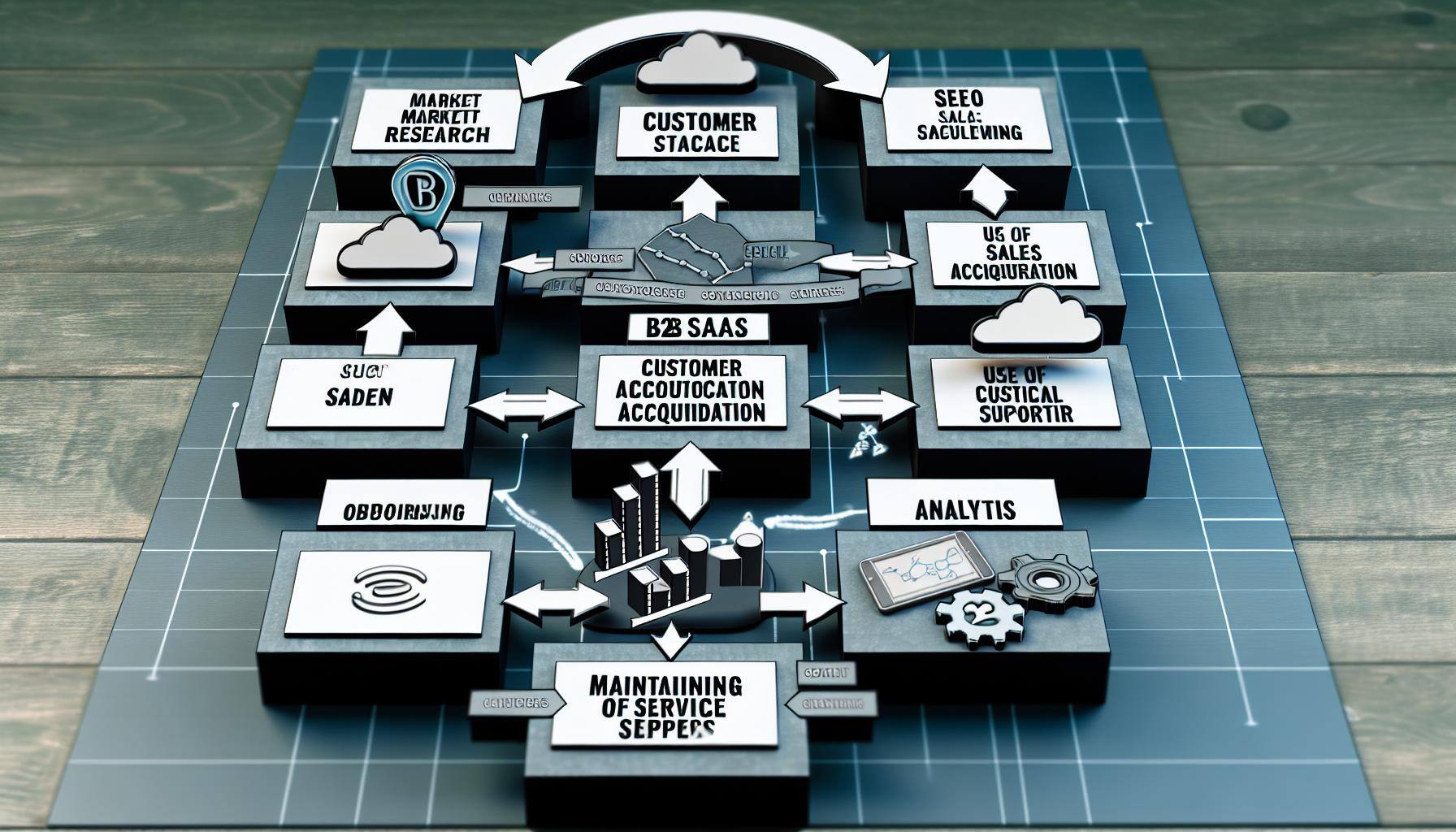Effective Ways to Reduce Customer Churn in B2B SaaS Companies
Customer churn represents a critical challenge for B2B SaaS companies. Churn occurs when customers stop using a product or service, leading to lost...
4 min read
Brian Polackoff
:
Sep 16, 2024 4:15:00 PM

The B2B SaaS industry continues to evolve at a rapid pace, necessitating innovative strategies to overcome the myriad of challenges inherent to achieving sustainable growth. As we look ahead to 2024, understanding these challenges and implementing actionable strategies is crucial for SaaS companies aiming to maintain a competitive edge. This article delves into the top challenges faced by B2B SaaS companies and suggests robust methods to tackle them effectively.
The SaaS market is characterized by its complexity, driven by rapid technological advancements, evolving customer expectations, and intense competition, highlighting the challenges of B2B SaaS. As many companies enter the market, distinguishing a SaaS product becomes increasingly difficult. B2B SaaS providers must navigate these complexities by continuously innovating their offerings and staying ahead of market trends to overcome the challenges of B2B. Understanding the intricacies of customer needs and the competitive landscape is essential for devising effective growth strategies.
B2B SaaS growth is hindered by several key challenges. Customer acquisition remains a significant hurdle, with companies striving to attract and convert high-quality leads. Additionally, retention rates are critical as maintaining existing customers is often more cost-effective than acquiring new ones. SaaS growth challenges also include scaling operations efficiently, managing cash flow, and maintaining a top-tier user experience amidst continuous product development. Identifying and addressing these key challenges can pave the way for sustainable growth.
Common challenges in the SaaS industry stem from diverse factors such as market saturation, rapid technological shifts, and regulatory changes. SaaS providers often grapple with the need for continuous innovation while balancing operational costs. Integration with existing systems and ensuring robust security also pose significant hurdles. Evaluating these common challenges and understanding their implications can help in formulating effective strategies for 2024.
Implementing targeted marketing and sales strategies is pivotal for SaaS growth, especially when addressing the challenges of B2B SaaS companies. Utilizing data-driven approaches allows SaaS companies to tailor campaigns to specific customer segments, thereby enhancing the efficiency of customer acquisition efforts. Content marketing, search engine optimization, and leveraging social proof through testimonials and case studies are effective techniques. Moreover, aligning sales and marketing teams ensures a cohesive strategy that drives conversion and retention.
LinkedIn has emerged as a powerful tool for B2B SaaS customer acquisition. The platform provides access to a vast network of professionals and decision-makers, making it ideal for targeted outreach. SaaS companies can utilize LinkedIn for lead generation through personalized connections, engaging content, and strategic advertising. LinkedIn's advanced analytics also enable marketers to track the performance of their campaigns and optimize accordingly.
Personalization is a critical element in enhancing the customer journey and driving acquisition, especially in the context of marketing strategies for B2B SaaS companies. By leveraging customer data, SaaS companies can create tailored experiences that resonate with individual users. Personalized recommendations, targeted content, and customized onboarding processes significantly improve user engagement and satisfaction. Implementing personalization strategies requires a deep understanding of customer needs and behaviors, enabled by advanced analytics and artificial intelligence tools.
A product-led growth (PLG) strategy places the product at the forefront of customer acquisition and retention efforts. This approach relies on delivering an exceptional user experience that drives organic growth through word-of-mouth and user advocacy, crucial for overcoming the challenges of B2B SaaS. The benefits of PLG include reduced customer acquisition costs, increased user satisfaction, and the ability to scale efficiently. By focusing on continuous product improvement and user-centric design, SaaS companies can foster a loyal customer base and achieve sustained growth.
While PLG offers numerous advantages, implementing this approach presents its own set of challenges. SaaS companies must invest in robust product development and ensure that their product consistently meets high standards of usability and functionality. Additionally, aligning the entire organization around a product-led mindset requires cultural shifts and cross-functional collaboration. Overcoming these challenges involves fostering a deep customer-centric culture and integrating feedback mechanisms to continually refine the product.
Examining case studies of successful product-led SaaS companies provides valuable insights into best practices and strategies for overcoming the challenges of B2B SaaS. Companies like Slack and Dropbox have exemplified the PLG approach by focusing on delivering exceptional user experiences that drive viral growth. These companies leverage freemium models, seamless onboarding, and user-centric design to attract and retain customers. Learning from their success can guide other SaaS firms in implementing effective PLG strategies to tackle the challenges and how to overcome them.
Demand generation is a comprehensive approach that encompasses all activities aimed at creating awareness and interest in a SaaS product. It involves a combination of inbound and outbound marketing techniques, content creation, and lead nurturing to generate high-quality leads. Understanding the demand generation process is crucial for SaaS companies to develop effective strategies that engage potential customers at every stage of their journey.
Top strategies for demand generation in 2024 focus on leveraging advanced technologies and data-driven insights to address the biggest challenges in the SaaS industry. Content marketing remains a cornerstone, but it is increasingly augmented by SEO, social media marketing, and influencer partnerships. Utilizing AI and machine learning to analyze customer data and predict trends allows for more targeted and efficient campaigns, essential for SaaS growth marketing. Additionally, webinars, virtual events, and interactive content are proving effective in engaging potential customers.
Overcoming demand generation challenges requires a multifaceted approach. SaaS companies must address issues such as market saturation, changing buyer behaviors, and the need for continuous innovation. Investing in marketing automation tools can streamline lead nurturing and follow-up processes. Additionally, fostering strong relationships with industry influencers and leveraging user-generated content can enhance credibility and reach. By continuously refining their strategies and staying attuned to market shifts, SaaS companies can effectively overcome demand generation challenges.
Identifying key business challenges in B2B SaaS is the first step towards overcoming them. Companies must recognize issues such as customer churn, scaling operations, maintaining cash flow, and ensuring product-market fit. Additionally, staying compliant with regulatory requirements and managing cybersecurity threats are critical concerns. A thorough analysis of these challenges enables SaaS companies to develop targeted strategies that address their unique business context.
Effective actionable strategies for 2024 involve a combination of innovation, customer-centricity, and operational efficiency. SaaS companies should focus on enhancing their product offerings through continuous development and feedback integration. Diversifying customer acquisition channels, leveraging data analytics to personalize user experiences, and optimizing pricing models are essential strategies. Furthermore, investing in employee training and fostering a collaborative culture can drive overall business performance.
Measuring the success of implemented strategies is essential to ensure continuous improvement and sustainable growth. Key performance indicators (KPIs) such as customer acquisition cost (CAC), lifetime value (LTV), churn rate, and user engagement metrics provide valuable insights. Regularly monitoring these metrics and conducting thorough analyses allow SaaS companies to gauge the effectiveness of their strategies and make necessary adjustments. Utilizing advanced analytics tools can further enhance the accuracy and efficiency of performance measurement.

Customer churn represents a critical challenge for B2B SaaS companies. Churn occurs when customers stop using a product or service, leading to lost...

Building a successful B2B SaaS (Business-to-Business Software as a Service) company requires a strategic approach and an in-depth understanding of...

In the realm of B2B SaaS startups, securing appropriate funding is often the cornerstone to success. Pre-seed venture capital (VC) is particularly...